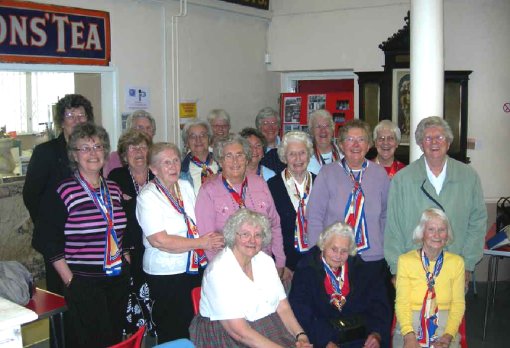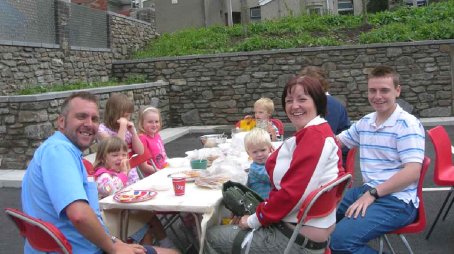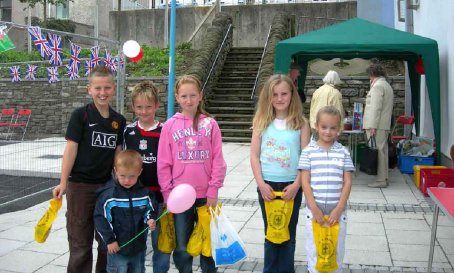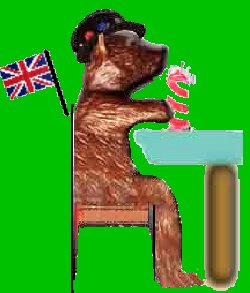Congratulations!!!
We have three lots of congratulations this month!
Congratulations to ADMS for being a runner-up in the awards scheme run by Blaenau Gwent District Council to celebrate the volunteer sector, both individuals and organisations. We may not have won in our category but the work of the Museum Society was recognised and Ron Selway accepted our runner-up award on behalf of the Society at a celebratory evening at Ebbw Vale Leisure Centre recently where a buffet and entertainment were laid on for finalists and guests. The evening was a eye-opener to the volunteer work that goes on behind the scenes, often unrecognised, but which makes an enormous contribution to the lives of Blaenau Gwent citizens.
Congratulations to Don and Peggy Bearcroft who recently received an award from Abertillery and Llanhilleth Community Council. They were nominated to receive a plaque in recognition of their work for the Museum Society and the presentation took place at their Awards Evening at the Indoor Bowls Centre where the presentations were followed by a buffet.
Double Congratulations to our Curator Don Bearcroft. Don has been selected as a regional winner under the Heritage – Individual category for the Wales region of the Nationwide Community and Heritage Awards Scheme. His commemorative award will be presented at Glamorgan Cricket Club in Cardiff in July (another buffet!). The national finalists will be announced at the event so fingers crossed Don will be one of the lucky names – he certainly deserves to be. As well as being a winner in the individual category, Don has also been selected as a Heritage Hero for the Wales region – a worthy recognition of his efforts for the Museum and for our local history in general over the years.
Well done Don, Peggy and everyone who helps makes the Museum Society the success story it clearly is.
Fund-raising June - £250
Diary Dates
No lectures July or August but look out for details of coffee mornings and exhibitions.
Saturday 19th July – Coffee Morning ‘Postcards’ please start looking for your special cards for this temporary exhibition (not too saucy, please!)
Wednesday 3rd September 2008 – Merthyr Artist 1900 by Scott Reid
Wednesday 1st October 2008 – Coal Shipping at South Wales Ports by Tony Jukes
Lectures start at 7.00pm in the Metropole Theatre, with teas and a chat downstairs in the Museum afterwards. Entry is £2 and the public are most welcome.
Coffee Morning – Saturday 19th July and the topic is ‘Postcards’. Don is hoping to stage an exhibition of some of the postcards in the Museum collection but we would also like to have your postcards to display so please start rummaging in those drawers and cupboards. As usual, it will be a sociable affair with tea and cakes (and, as usual, donations of cakes will be very welcome).
Poet’s Corner
‘DARKENING MILES’
A lone cyclist hurries home,
along an almost traffic free road,
Evening air becoming still,
before light starts to fade.
Pedals spin with urgency,
Rubber shod spinning wheels
making comforting rhythmic sounds,
speeding over tarred chippings
Bordering forest form opaque glades,
where lurk imaginary danger,
While jackdaws go to rest
after roll call where they gather.
Leaden cloud darkens sky,
Temperature drops as night falls,
Comfortable warmth of home
with food and drink loudly calls.
Another physical demanding ride
is swiftly drawing to its close,
While fuelled by fresh air,
into his mind fantasy flows.
When secure haven is reached,
rest taken and motion ceases,
Satisfaction will accompany tiredness
as hot water soothes aching muscles.
Thoughts will turn to races;
entered and soon to come,
Where preparation such as this
could give him another win.
Gordon Rowlands, September 2000
100 Club
We still need more people to join – just £1 per month and a chance to win a monthly prize of £25, £10 or £5. The draw is usually made at the lectures but in non-lecture months the draw is either held at a coffee morning or other event, or held over to be drawn the following month.
A Nostalgic Afternoon
For many years a Saturday towards the end of June has been earmarked for “The Hospital Fete”. Sadly this is no longer necessary. The money made at the fete was used for the benefit and comfort of the patients. However, the building is to close, probably by the end of the year. What will happen to the actual building is unknown.
On a very happy note the League of Friends organised a “thank you” party on Saturday 24th June. Everyone who had helped was invited and although the weather was not very good we had a lovely time. A founder member of the League of Friends, Mrs Eileen Lee, gave a short talk as did Wendy West who had worked for many years to make the fete a success. The buffet was delicious; we all enjoyed it. Several of my party went and had a last look round the hospital. What a lovely place it is. The lovely tiles and the curved part where wall and floor meet, obviously meant that in those days hygiene was high on the list of priorities. The windows are leaded, the doors oak, and everything seemed to be of the highest quality.
We left the party fully replete and hoped that Aberbeeg Hospital will not be demolished but put to some health use again.
The Roving Reporter
Local Voices
‘Old Fashioned Toys are Still the Best’
Recently my five year old grand daughter came to stay for a few days. She had everything imaginable in the way of toys and yet what did she enjoy doing most and practically the whole time? SKIPPING. Granted she had a pretty skipping rope whereas I had a piece of plaited rope from an orange box but that little girl skipped and skipped. As the weather was bad she was allowed to play in the hallway and when choosing something less energetic what did she want to play? SNAP. Nana
Pigeons
Feral pigeons may be a nuisance in our cities but racing pigeons are a different matter altogether. The National Homing Union (now the Royal Pigeon Racing Association) was set up in 1896 and soon attracted royal patronage which continues to the present day. The first pigeon races were conducted over quite short distances but that all changed with the advent of the railways. Rail transport dominated the sport until the Beeching cuts in the 1960s and the subsequent introduction of the pigeon transporters we see on the roads today. The popularity of the sport peaked in the war and the fifities although there were still as many as 60,000 members in 1898. The decline is all too evident locally with many fewer pigeon lofts than used to be the case.
When WW2 broke out, thousands of pigeon fanciers gave their pigeons to help the war effort; the birds were used by the army, RAF, Civil Defence Services, Home Guard and Bletchley Park to name just a few and their importance was such that birds of prey were culled along the south coast to increase the chances of the pigeons returning safely. Tight controls were maintained over pigeon keeping and pigeon corn was rationed. All RAF bombers and reconnaissance aircraft carried pigeons (in special watertight containers) and on several occasions lives were saved when a downed aircraft released a pigeon with the co-ordinates to facilitate rescue. Pigeons carried their messages in special containers on their legs or in pouches looped over their backs and no less than 53 Dickin Medals (a medal for any animal displaying conspicuous gallantry during WW2 and its aftermath) were presented to pigeons. A few of their stories are reproduced below:
“White Vision” carried a message from a RAF crew on a flying boat which had to ditch in the Hebrides at eight o’ clock one morning in very bad weather with poor visiblility which hindered the rescue effort. Despite appalling conditions White Vision arrived back at her loft in the afternoon with the co-ordinates of the ditched craft; the search was resumed and the aircrew were rescued.
“Beach Comber” brought the first news to this country of the landing at Dieppe while serving with the Canadian Army.
“Scotch Lass” brought 38 microphotographs across the North Sea despite being injured, while serving with the RAF in Holland.
“Princess” was sent on a special mission to Crete and safely returned to her loft at RAF Alexandria, a journey involving a distance of about 500 miles, mostly over sea.
More recently the national press reported that prisoners at a jail in Brazil had been training pigeons to fly in contraband. Several birds were found carrying drugs or mobile phones in pouches on their backs, some being so heavily laden they could barely fly.
Source: Royal Racing Pigeon Association website (mostly)
Hedge Laying
We have all seen hedges laid by cutting the stems and bending them over (pleaching); the hedge is staked and binders woven in to give the appearance of a large woven sculpture. This has been the traditional way of hedge management for centuries and in 57BC Caesar described similar techniques used in Flanders. Hedges were laid in Britain by the Romans but the main period was during the enclosures. The introduction of modern farming techniques after WW2 saw the grubbing up of hundreds of miles of hedgerows but that slowed with the introduction of legislation and a greater awareness of conservation issues. Interest in the craft is increasing and well attended courses are held regularly throughout the country. The favoured species for hedging include blackthorn, hawthorn, hazel, elm ash and field maple – all serving to help keep stock in, provide shelter and act as a wildlife corridor. Did you know that there are different styles of hedge? Here are just a few:
Midland style originally designed to keep heavy bullocks in their fields.
Border style found in Brecon and and the Borders, is a double brush hedge with stakes driven in at 35-degree slant, 30" apart. Dead wood is used in the hedge to protect the regrowth from being browsed by stock. The dead wood and live layers are bound down the centre line, with top and side of hedge being trimmed.
Flying style which incorporates a bank, found in Monmouthshire, Pembroke, Gower and Carmarthen.
Books for you
COMING UP ROSES - STORIES OF GARDENS AND LIFE by Caroline Oakley
Published February 2008 by Honno Price £7.99
ISBN 9781870206938 (1870206932)
A fiction anthology from Welsh women writing about gardens: what they mean to them, what happens in them and where they take them. There are sad stories and happy ones, tales from home and abroad - all of them share a love for plants and planting, flowers and seeds, a real sense of the power of growing things to change lives.
MUSEUM MATTERS
After our holiday we came back to a hectic time in the museum, on the first Tuesday a Disability Training Day was held at the museum. The Trainer was Gail Williams of Disability Wales, Gail who is a disabled person herself and has two disabled sons', talks with first hand knowledge about the obstacles faced by disabled people. We learned that there are many types of specific needs people and children also what their needs and requirements are. Our museum has good access but there are still a few things that we can provide to ensure that everyone has full access to enjoy our museum. Thank you Gail for enlightening us in this subject the lessons learned will be put into operation I promise!
On the Wednesday a group visit by the Cwmbran Trefoil Guild had been arranged. It is part of my job as curator to welcome visiting groups which I always find enjoyable as compared with some of the mundane but essential work that I have to do. The ladies were very impressed with the museum and the way it is set out, commenting that it engenders a friendly atmosphere. They also told of the friendliness and courtesy which they were greeted with by our volunteers, this I told them is because we love our museum and are pleased to show it off to others.

Saturday was the monthly meeting of our Children's Club; it was also the first Saturday of ABERFEST week so together with Rachel and Shelley of Com/First we decided to hold a 1945 End of the War Street Party in the area outside the museum. The party would be open to all children not just the ones in our Saturday club, adults could also have refreshments by paying a £1.
 A grant was applied for from Communities First the pay for the bunting, decorated paper plates and cups, we also decided to give the children museum mugs to commemorate the occasion. There was a lot of time and effort put in by the members of our society in the days before the event; Rachel and Shelley of Com/First were busy arranging and coordinating with us and the authorities. The ladies had been busy making cakes, jellies etc but it was decided that to keep the sandwiches fresh they would be cut on the morning of the party. We made an early morning start; the weather forecast was unsettled, bearing in mind what had happened in previous years we were undecided whether to hold it outdoors or in the museum. A
A grant was applied for from Communities First the pay for the bunting, decorated paper plates and cups, we also decided to give the children museum mugs to commemorate the occasion. There was a lot of time and effort put in by the members of our society in the days before the event; Rachel and Shelley of Com/First were busy arranging and coordinating with us and the authorities. The ladies had been busy making cakes, jellies etc but it was decided that to keep the sandwiches fresh they would be cut on the morning of the party. We made an early morning start; the weather forecast was unsettled, bearing in mind what had happened in previous years we were undecided whether to hold it outdoors or in the museum. A Street Party is not the same indoors so we set it up outside hoping for the best. The children in our Saturday Club came and together with Shelley’ daughter Cariad carried on with their projects. Meanwhile other children together with their parents arrived for the party, I was giving the children their mugs and watched amazed as one group after another sat down for their food.
Street Party is not the same indoors so we set it up outside hoping for the best. The children in our Saturday Club came and together with Shelley’ daughter Cariad carried on with their projects. Meanwhile other children together with their parents arrived for the party, I was giving the children their mugs and watched amazed as one group after another sat down for their food.
Inside the museum was a hub of activity, Peggy remarked that she had never seen so many people in the museum before, well over 200 people visited the musem! It was a marvellous success.
In the afternoon we were able to go through the town and view the other activities that were going on. In the evening Peggy and I attended the 48th Anniversary Memorial Service for the Six Bells Pit Disaster as we always do. This year the Address was given by the Revd Cllr Peter Abbot, of St Paul's Cwm, he spoke of the pain and suffering that has been the lot of the mining valleys of South Wales as only a man of the valleys can do. It is not surprising as he was brought up in the Senghenydd Valley where the Universal Colliery disaster October 13th 1913 when 413 men and boys lost their lives.
 The street party was a success thanks to the hard work of our members, Rachel, Shelley and Cariad. ABERFEST was a success and the Community Council, Communities First an all who took part should be congratulated. It is this and similar events that keep the community spirit alive in our valley
The street party was a success thanks to the hard work of our members, Rachel, Shelley and Cariad. ABERFEST was a success and the Community Council, Communities First an all who took part should be congratulated. It is this and similar events that keep the community spirit alive in our valley
Don Bearcroft Curator
